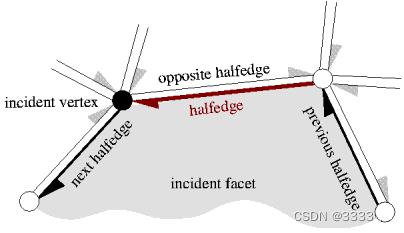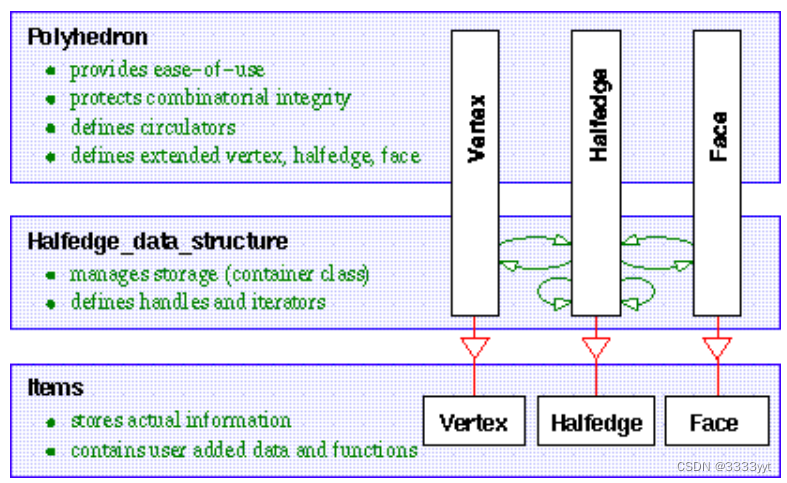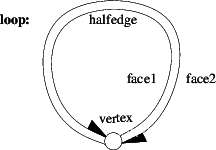CGAL笔记之单元格复合体和多面体篇—半边数据结构
1 介绍
半边数据结构(缩写为HalfedgeDS,或HDS用于模板参数)是一种以边为中心的数据结构,能够维护顶点、边和面的关联信息,例如平面地图、多面体或其他可定向的二维表面嵌入在任意维度。每条边被分解为两个方向相反的半边。每个半边存储一个入射面和一个入射顶点。对于每个面和每个顶点,存储一个关联的半边。半边数据结构的简化变体可以省略其中一些信息,例如面中的半边指针或面的存储。

halfedge 数据结构是一种组合数据结构,几何解释由建立在 halfedge 数据结构之上的类添加。这些类可能比直接使用 halfedge 数据结构更方便,因为 halfedge 数据结构意味着作为一个实现层。
此处提供的数据结构也称为 FE 结构、halfedges 、或双连接边列表 (DCEL) ,尽管 DCEL 的原始参考描述了不同的数据结构。半边数据结构也可以看作是四边数据结构的变体之一。通常,四边形数据可以表示不可定向的 2-流形,但此处的变体仅限于可定向的 2-流形。
2 程序设计

图说明了软件设计的三层职责,以Polyhedron_3顶层为例。项为实际存储的信息提供了空间,即在Vertex, Halfedge, 和Face分别。半边需要提供对下一个半边和相对半边的引用。可选地,它们可以提供对先前半边、入射顶点和入射面的参考。顶点和面可能是空的。可选地,它们可以提供对事件 halfedge 的引用。半边数据结构和多面体支持提到的选项,例如,欧拉运算更新可选引用(如果存在)。此外,项目类可以使用任意属性和成员函数进行扩展,这些属性和成员函数将通过继承提升到用于多面体的实际类。
顶点、半边和面作为类的局部类型传递Items给半边数据结构和多面体。提供了满足要求的强制性部分的顶点、半边和面的实现。它们可以用作用户扩展的基类。还提供了更丰富的实现作为默认值;对于多面体,它们提供了所有可选的关联,顶点类型中的三维点和面类型中的平面方程。
Halfedge 数据结构概念HalfedgeDS,负责项目的存储组织。当前,提供了在内部使用双向列表或向量的实现。定义HalfedgeDS属于项的句柄和迭代器。这些类型被提升为项目本身的声明,并在那里用于提供对事件项目的引用。Refs这种类型的提升是通过项目类型的模板参数完成的。halfedge 数据结构提供成员函数来插入和删除项目,遍历所有项目,并提供对项目的访问。
这个HalfedgeDS概念有两种不同的模型,HalfedgeDS_list并且HalfedgeDS_vector,可能还会有更多。因此,我们保持它们的接口较小,并将通用功能分解为单独的辅助类、HalfedgeDS_decorator、HalfedgeDS_const_decorator和HalfedgeDS_items_decorator,它们未在图中显示,但将放置在HalfedgeDS因为他们扩大了界面但没有隐藏它。这些辅助类包含有助于实现下一层操作的操作,例如多面体。例如,他们添加了欧拉运算和部分运算,从中可以构建进一步的欧拉运算,例如在顶点处将边插入到边环中。此外,辅助类包含自适应功能。例如,如果HalfedgeDSHalfedge::prev()没有为 halfedges 提供成员函数,则HalfedgeDS_items_decorator::find_prev()辅助类的成员函数会沿面的正方向搜索前一个 halfedges。但是如果HalfedgeDSHalfedge::prev()提供了成员函数,HalfedgeDS_items_decorator::find_prev()成员函数只是调用它。这种区别在编译时通过称为编译时标记的技术解决,类似于迭代器标签。
作为Polyhedron_3第三层的例子,增加了几何解释,提供了一个易于使用的高级功能接口,并统一了对底层提供的灵活性的访问。它将面重命名为面,这对于三维表面更常见。该界面旨在保护内部表示的完整性,存储在项目中的句柄不能再由用户直接编写。多面体添加了方便高效的环行器,用于访问顶点或小平面周围的圆形边序列。为实现这一点,Polyhedron_3从中提供的那些派生新的顶点、半边和面Items。这些新项目是实际使用的项目HalfedgeDS,这为我们提供了此设计中连贯的类型结构。
3 示例程序
3.1 默认的半边数据结构
以下示例程序使用默认的 halfedge 数据结构和装饰器类。默认的半边数据结构使用基于列表的表示。定义了项目的所有关联和顶点的点类型。trivial traits 类提供了用于点的类型。该程序创建一个循环,由两个半边、一个顶点和两个面组成,并检查其有效性。

#include <CGAL/HalfedgeDS_default.h>
#include <CGAL/HalfedgeDS_decorator.h>
#include <cassert>
struct Traits { typedef int Point_2; };
typedef CGAL::HalfedgeDS_default<Traits> HDS;
typedef CGAL::HalfedgeDS_decorator<HDS> Decorator;
int main() {
HDS hds;
Decorator decorator(hds);
decorator.create_loop();
assert( decorator.is_valid());
return 0;
}
3.2 最小半边数据结构
以下程序使用最小项类HalfedgeDS_min_items和基于列表的半边数据结构定义了最小半边数据结构。结果是一个数据结构只维护带有 next 和 opposite 指针的半边。没有存储顶点或面。数据结构表示无向图。
#include <CGAL/HalfedgeDS_min_items.h>
#include <CGAL/HalfedgeDS_default.h>
#include <CGAL/HalfedgeDS_decorator.h>
#include <cassert>
// no traits needed, argument can be arbitrary dummy.
typedef CGAL::HalfedgeDS_default<int, CGAL::HalfedgeDS_min_items> HDS;
typedef CGAL::HalfedgeDS_decorator<HDS> Decorator;
int main() {
HDS hds;
Decorator decorator(hds);
decorator.create_loop();
assert( decorator.is_valid());
return 0;
}
3.3 使用向量而不是列表的默认值
默认的 halfedge 数据结构在内部使用一个列表和最大基类。我们在这里将列表更改为矢量表示。同样,一个普通的特征类提供了用于点的类型。请注意,对于向量存储,半边数据结构的大小应事先保留,可以使用示例中所示的构造函数或成员函数reserve()。稍后可以通过进一步调用reserve()成员函数来调整数据结构的大小,但前提是数据结构处于一致的状态,即有效状态。
#include <CGAL/HalfedgeDS_items_2.h>
#include <CGAL/HalfedgeDS_vector.h>
#include <CGAL/HalfedgeDS_decorator.h>
#include <cassert>
struct Traits { typedef int Point_2; };
typedef CGAL::HalfedgeDS_vector< Traits, CGAL::HalfedgeDS_items_2> HDS;
typedef CGAL::HalfedgeDS_decorator<HDS> Decorator;
int main() {
HDS hds(1,2,2);
Decorator decorator(hds);
decorator.create_loop();
assert( decorator.is_valid());
return 0;
}
3.4 为面添加颜色的示例
此示例重新使用可用于人脸的基类并添加一个成员变量color。
#include <CGAL/HalfedgeDS_items_2.h>
#include <CGAL/HalfedgeDS_default.h>
#include <CGAL/IO/Color.h>
#include <cassert>
// A face type with a color member variable.
template <class Refs>
struct My_face : public CGAL::HalfedgeDS_face_base<Refs> {
CGAL::IO::Color color;
My_face() {}
My_face( CGAL::IO::Color c) : color(c) {}
};
// An items type using my face.
struct My_items : public CGAL::HalfedgeDS_items_2 {
template <class Refs, class Traits>
struct Face_wrapper {
typedef My_face<Refs> Face;
};
};
struct My_traits { // arbitrary point type, not used here.
typedef int Point_2;
};
typedef CGAL::HalfedgeDS_default<My_traits, My_items> HDS;
typedef HDS::Face Face;
typedef HDS::Face_handle Face_handle;
int main() {
HDS hds;
Face_handle f = hds.faces_push_back( Face( CGAL::IO::red()));
f->color = CGAL::IO::blue();
assert( f->color == CGAL::IO::blue());
return 0;
}
3.5 定义更紧凑的半边的示例
此处介绍的半边数据结构的空间效率略低,例如翼边数据结构、DCEL 或四边数据结构的变体。另一方面,它在遍历过程中不需要任何搜索操作。
以下示例使用传统 C 技术(即类型转换和指针,尤其是来自mallocor 的指针new,指向偶数地址的指针)以遍历时间换取紧凑的存储表示。这个想法如下:halfedge 数据结构成对分配 halfedges。关于基于向量的数据结构,这意味着相对于 C 指针算法,半边与其相反的半边之间的差的绝对值始终为 1。我们可以用编码此差异符号的单个位来替换相反的指针。我们将把这个位存储为下一个半边句柄中的最低有效位。此外,我们没有实现指向前半边的指针。剩下的是每个半边三个指针。
我们使用静态成员函数HalfedgeDS::halfedge_handle()将指针转换为半边句柄。相同的解决方案可以应用于基于列表的 halfedge 数据结构HalfedgeDS_list,这是基于向量的数据结构的示例。
#include <CGAL/HalfedgeDS_items_2.h>
#include <CGAL/HalfedgeDS_vector.h>
#include <CGAL/HalfedgeDS_decorator.h>
#include <cstddef>
#include <cassert>
// Define a new halfedge class. We assume that the Halfedge_handle can
// be created from a pointer (e.g. the HalfedgeDS is based here on the
// In_place_list or a std::vector with such property) and that halfedges
// are allocated in pairs. We encode the opposite pointer in a single bit,
// which is stored in the lower bit of the next-pointer. We use the
// static member function HDS::halfedge_handle to translate pointer to
// handles.
template <class Refs>
class My_halfedge {
public:
typedef Refs HDS;
typedef My_halfedge<Refs> Base_base;
typedef My_halfedge<Refs> Base;
typedef My_halfedge<Refs> Self;
typedef CGAL::Tag_false Supports_halfedge_prev;
typedef CGAL::Tag_true Supports_halfedge_vertex;
typedef CGAL::Tag_true Supports_halfedge_face;
typedef typename Refs::Vertex_handle Vertex_handle;
typedef typename Refs::Vertex_const_handle Vertex_const_handle;
typedef typename Refs::Halfedge Halfedge;
typedef typename Refs::Halfedge_handle Halfedge_handle;
typedef typename Refs::Halfedge_const_handle Halfedge_const_handle;
typedef typename Refs::Face_handle Face_handle;
typedef typename Refs::Face_const_handle Face_const_handle;
private:
std::ptrdiff_t nxt;
public:
My_halfedge() : nxt(0), f( Face_handle()) {}
Halfedge_handle opposite() {
// Halfedge could be different from My_halfedge (e.g. pointer for
// linked list). Get proper handle from 'this' pointer first, do
// pointer arithmetic, then convert pointer back to handle again.
Halfedge_handle h = HDS::halfedge_handle(this); // proper handle
if ( nxt & 1)
return HDS::halfedge_handle( &* h + 1);
return HDS::halfedge_handle( &* h - 1);
}
Halfedge_const_handle opposite() const { // same as above
Halfedge_const_handle h = HDS::halfedge_handle(this); // proper handle
if ( nxt & 1)
return HDS::halfedge_handle( &* h + 1);
return HDS::halfedge_handle( &* h - 1);
}
Halfedge_handle next() {
return HDS::halfedge_handle((Halfedge*)(nxt & (~ std::ptrdiff_t(1))));
}
Halfedge_const_handle next() const {
return HDS::halfedge_handle((const Halfedge*)
(nxt & (~ std::ptrdiff_t(1))));
}
void set_opposite( Halfedge_handle h) {
assert(( &* h - 1 == &* HDS::halfedge_handle(this)) ||
( &* h + 1 == &* HDS::halfedge_handle(this)));
if ( &* h - 1 == &* HDS::halfedge_handle(this))
nxt |= 1;
else
nxt &= (~ std::ptrdiff_t(1));
}
void set_next( Halfedge_handle h) {
assert( ((std::ptrdiff_t)(&*h) & 1) == 0);
nxt = ((std::ptrdiff_t)(&*h)) | (nxt & 1);
}
private: // Support for the Vertex_handle.
Vertex_handle v;
public:
// the incident vertex.
Vertex_handle vertex() { return v; }
Vertex_const_handle vertex() const { return v; }
void set_vertex( Vertex_handle w) { v = w; }
private:
Face_handle f;
public:
Face_handle face() { return f; }
Face_const_handle face() const { return f; }
void set_face( Face_handle g) { f = g; }
bool is_border() const { return f == Face_handle(); }
};
// Replace halfedge in the default items type.
struct My_items : public CGAL::HalfedgeDS_items_2 {
template <class Refs, class Traits>
struct Halfedge_wrapper {
typedef My_halfedge<Refs> Halfedge;
};
};
struct Traits { typedef int Point_2; };
typedef CGAL::HalfedgeDS_vector<Traits, My_items> HDS;
typedef CGAL::HalfedgeDS_decorator<HDS> Decorator;
int main() {
HDS hds(1,2,2);
Decorator decorator(hds);
decorator.create_loop();
assert( decorator.is_valid());
return 0;
}
3.6 使用半边迭代器的示例
在默认的 halfedge 数据结构中创建了两条边。halfedge 迭代器用于计算 halfedges。
#include <CGAL/HalfedgeDS_default.h>
#include <CGAL/HalfedgeDS_decorator.h>
#include <cassert>
struct Traits { typedef int Point_2; };
typedef CGAL::HalfedgeDS_default<Traits> HDS;
typedef CGAL::HalfedgeDS_decorator<HDS> Decorator;
typedef HDS::Halfedge_iterator Iterator;
int main() {
HDS hds;
Decorator decorator(hds);
decorator.create_loop();
decorator.create_segment();
assert( decorator.is_valid());
int n = 0;
for ( Iterator i = hds.halfedges_begin(); i != hds.halfedges_end(); ++i )
++n;
assert( n == 4); // == 2 edges
return 0;
}
3.7 构建边缘迭代器的适配器示例
在默认的 halfedge 数据结构中创建了三个边。适配器N_step_adaptor用于声明用于对边进行计数的边迭代器。
#include <CGAL/HalfedgeDS_default.h>
#include <CGAL/HalfedgeDS_decorator.h>
#include <CGAL/N_step_adaptor.h>
#include <cassert>
struct Traits { typedef int Point_2; };
typedef CGAL::HalfedgeDS_default<Traits> HDS;
typedef CGAL::HalfedgeDS_decorator<HDS> Decorator;
typedef HDS::Halfedge_iterator Halfedge_iterator;
typedef CGAL::N_step_adaptor< Halfedge_iterator, 2> Iterator;
int main() {
HDS hds;
Decorator decorator(hds);
decorator.create_loop();
decorator.create_segment();
assert( decorator.is_valid());
int n = 0;
for ( Iterator e = hds.halfedges_begin(); e != hds.halfedges_end(); ++e)
++n;
assert( n == 2); // == 2 edges
return 0;
}























 182
182











 被折叠的 条评论
为什么被折叠?
被折叠的 条评论
为什么被折叠?








